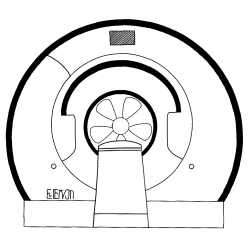Over the past few years, there is a keen interest in the integration of MR alone into radiation treatment planning and even the therapy workflow, i.e. MR-guided radiotherapy (MRgRT), to leverage its superior soft-tissue contrast. The abdomen, however, represents a challenging treatment site for pursuing these applications, in part due to respiratory motion and the presence of many organs-at-risk (OARs). Dr. Fan’s lab has developed several techniques related to image acquisition and post-processing of 4D-MR that can reliably depict abdominal organs and tumors and assess their respiratory motion trajectories. Representative achievements are:
Our team developed a 4D-MR technique based on 3D continuous radial-sampling spoiled gradient-echo for data acquisition and self-gating for respiratory motion detection. Data were retrospectively sorted into different respiratory phases, and each phase was reconstructed by means of self-calibrating CG-SENSE that can well handle undersampling problems. This technique eliminates the need for external motion surrogate set up, allows for the exclusion of irregular breathing cycles after scanning, and facilitates the reconstruction of an averaged phase-resolved isotropic-spatial-resolution volumetric image series with consistent image quality throughout all respiratory phases and subjects. A post-processing method, named iterative motion correction and average (United States Patent US10605880B2), was later developed to significantly improve 4D-MR image quality.
We are currently working on automated organ segmentation on MR images. Accurate and efficient delineation of the target and OARs is highly desirable for RTP, particularly for online adaptive MRgRT. However, manual delineation is still a common practice and a well-known time-consuming and interobserver variation-prone process. Deep learning has recently demonstrated great promise in tackling complex multi-organ segmentation problems in MR images. We have recently proposed a 2D DenseUnet approach to perform automated segmentation on 3D T1-weighted abdominal images. A multi-view approach by performing parallel 2D-based segmentation in the axial, coronal and sagittal views was proposed to considerably improve segmentation accuracy.
Dr. Fan was awarded by NIH/NCI in 2019 an R21 grant to develop a 4D-MR technique for monitoring pancreatic tumor infiltrating blood vessels and tumor response to chemoradiation therapy. An R01 grant was funded in 2020 by NIH/NIBIB, aiming to develop a multi-task MR imaging technique for abdominal radiotherapy planning.

Representative Publications
- Yang W, Fan Z, Tuli R, Deng Z, Pang J, Wachsman A, Reznik R, Sandler H, Li D, Fraass BA. Four-dimensional magnetic resonance imaging with 3-dimensional radial sampling and self-gating-based K-space sorting: early clinical experience on pancreatic cancer patients. International Journal of Radiation Oncology, Biology, Physics 2015;93:1136-1143.
- Deng Z, Pang J, Yang W, Yue Y, Sharif B, Tuli R, Li D, Fraass B, Fan Z. Four-dimensional MRI using three-dimensional radial sampling with respiratory self-gating to characterize temporal phase-resolved respiratory motion in the abdomen. Magnetic Resonance in Medicine 2016;75:1574-1585.
- Deng Z, Pang J, Lao Y, Bi X, Wang G, Chen Y, Fenchel M, Tuli R, Li D, Yang W, Fan Z. A post-processing method based on inter-phase motion correction and averaging to improve image quality of 4D magnetic resonance imaging: a clinical feasibility study. British Journal of Radiology 2019;92:20180424.
- Chen Y, Ruan D, Xiao J, Wang L, Sun B, Saouaf R, Yang W, Li D, Fan Z. Fully automated multi-organ segmentation in abdominal magnetic resonance imaging with deep neural networks. arXiv:1912.11000.
